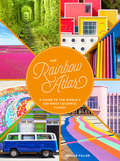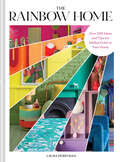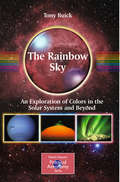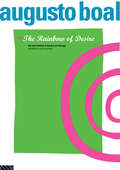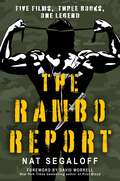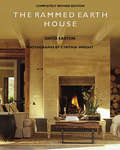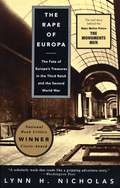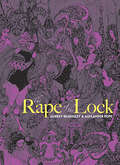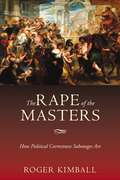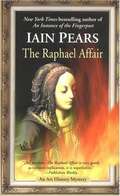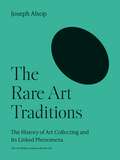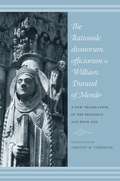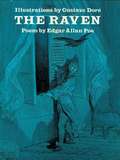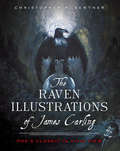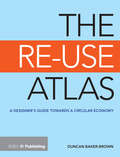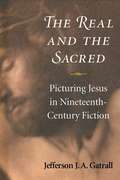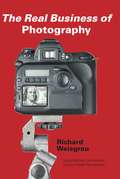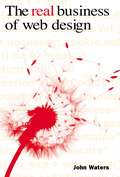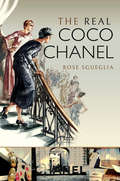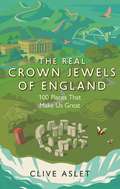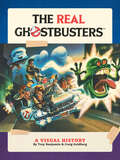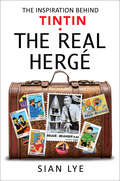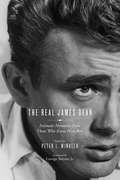- Table View
- List View
The Rainbow Atlas: A Guide to the World's 500 Most Colorful Places
by Taylor FullerTake a colorful tour of 500 eye-poppingly brilliant spots around the world with The Rainbow Atlas. Spanning natural phenomena, architectural wonders, art installations, and more, the contents of this book range from the pink salt lakes of Mexico's Yucatan Peninsula to the eye-catching home façades of Cobh, Ireland.Spectacularly colorful and packed with dreamy photographs, The Rainbow Atlas introduces readers to the most vibrant landmarks the world has to offer.• Entries offer surprising facts and expert advice on when to visit these surreal settings.• Provides readers with hours of inspiration for their future adventures• Explore and learn about places like China's Rainbow Mountains and the colorful streets of Cape Town.The Rainbow Atlas is organized by longitude, creating fun and unexpected juxtapositions. Paired with stunning photographs of each location, The Rainbow Atlas advises readers of the best time of year to visit each spot and explains the particularities of each riotous rainbow locale. • Spectacularly colorful and packed with dreamy rainbow content• The perfect and unique book for adventure seekers, color enthusiasts, photographers, rainbow chasers, travel addicts, and explorers everywhere• Add it to your collection of books like Atlas Obscura: An Explorer's Guide to the World's Hidden Wonders by Joshua Foer, Dylan Thuras, and Ella Morton; The Bucket List: 1000 Adventures Big & Small by Kath Stathers; and The Secret Lives of Color by Kassia St Clair
The Rainbow Home: Over 200 Ideas and Tips for Adding Color to Your Home
by Laura PerrymanBring a rainbow of joy into your life with colorful home design and decor inspiration. The Rainbow Home features hundreds of easy DIYs and tips from leading home influencers for homeowners, renters, and anyone inspired by color.Many homes have color in them, but a rainbow home is one that uses color in a particular way. This could be a bright pop of surprising color, a room that pairs clashing colors, an intense use of pattern, or a clear rainbow effect. The overall feel is that the color is there to bring joy and to create a home that is extremely personal and unique. Like Pinterest at your fingertips, The Rainbow Home is the go-to reference book that makes it easy to define your own rainbow style and add color anywhere in your home. Divided by area (house front and doorways, hallways and stairs, living spaces, kitchens, eating and entertaining, sleeping spaces, bath and relaxation, home offices and craft rooms, storage solutions, and outdoor space), each chapter includes: Lots of clever DIYs, purchasable ideas, and photographic inspiration. An exploration of the three distinct “types” of rainbow colors: dopamine brights (intense bold and joyful colors), playful pastels (nostalgic and sweeter chromas), and uplifting neons (electric and punchy hues). A deeper dive into specific colors, breaking down the benefits of each, how to choose which shade is right for you, and a color pairing guide. Feature profiles on notable décor personalities, taking a peek into their colorful homes and sharing their advice, including such luminaries as Evie Kemp (@eviekemp), Stasia Buckle (@stasiabuckle), Maye Ruiz (@mayeruz), Lizzy Hingham (@lizzyhigham_interiorstyling), Shareen and Martin (@happyvillageinterior), and Sisi Alfred (@homewithsisi). A brilliant interior design coffee table book, The Rainbow Home is outstanding as a self-purchase for color enthusiasts, a housewarming present, or a handy guidebook for designers, stylists, color consultants, decorators, and creatives of all types.THOUSANDS OF DÉCOR IDEAS: Over 600 images with corresponding ideas and tips are included, so you’ll never run out of inspiration for your home. LEADING DÉCOR EXPERTS: This irresistibly aesthetic book features the dazzling homes and interiors of top #rainbowhome influencers who share their seasoned advice for making your home feel fun and colorful. RENTER-FRIENDLY TIPS & TRICKS: Much of the book’s advice is adaptable to a wide variety of spaces and budgets. Decorative paint and décor can be temporary or easily removed, so you don’t have to sacrifice your deposit to have a colorful home!Perfect for: Anyone interested in home décor and DIY ideas, maximalism, and design New apartment, house, or condo renters or owners looking for decorating inspiration Host or hostess gift-giving Fans of rainbows and colorful textiles, art, and collectibles
The Rainbow Sky
by Tony BuickThere are many more astronomical and meteorological phenomena involving color than most people are aware of, let alone have observed. Visual double stars with contrasting color are obvious targets for amateur astronomers, but there are many more - everything from colors on the Moon, through colors on the planets and in deep-sky objects, to man-made colors in the night sky. A great deal of these colored phenomena can be seen with the unaided eye, and can be visible in - and imaged with - a modest telescope, but all require preparation, anticipation and planning. The result will be some breathtaking sights, along with some amazing images. Just browsing through this book will captivate the reader. Some events are familiar but present severe challenges to photograph. Some can be captured only by using previously unfamiliar techniques. And it is almost certain that some will never have been seen before by readers. All the colored objects and phenomena are accessible by using the right techniques, for which Tony Buick provides easy-to-follow instructions.
The Rainbow of Desire: The Boal Method of Theatre and Therapy
by Augusto BoalRainbow of Desire is a handbook of exercises with a difference. It is Augusto Boal's bold and brilliant statement about the therapeutic ability of theatre to liberate individuals and change lives. Now translated into English and comprehensively updated from the French, Rainbow of Desire sets out the techniques which help us `see' for the first time the oppressions we have internalised. Boal, a Brazilian theatre director, writer and politician, has been confronting oppression in various forms for over thirty years. His belief that theatre is a means to create the future has inspired hundreds of groups all over the world to use his techniques in a multitude of settings. This, his latest work, includes such exercises as: * The Cops in the Head and their anti-bodies * The screen image * The image of the future we are afraid of * Image and counter-image ....and many more. Rainbow of Desire will make fascinating reading for those already familiar with Boal's work and is also completely accessible to anyone new to Theatre of the Oppressed techniques.
The Rambo Report: Five Films, Three Books, One Legend
by Nat SegaloffThe ultimate guide to the Rambo phenomenon—from bestselling novel to Hollywood blockbuster to all-American hero, legend, and icon—written with the full cooperation of Rambo&’s creator, bestselling author David Morrell . . . From the beginning, Rambo was more than a character in a 1972 novel by David Morrell. He was the culmination of the author&’s personal encounters with veterans returning from the Vietnam War. The 1982 movie adaptation of First Blood reflected the novel&’s powerful insights into a troubled veteran&’s postwar experience. Then in 1985, the film&’s explosive sequel Rambo: First Blood Part II transformed the character into something shockingly different. With a focus on blood-and-guts action—and the beefed-up muscles of Sylvester Stallone—Rambo became an invincible one-man army. A new kind of hero for a new day in America. A full-blown pop-culture icon as controversial as he was crowd-pleasing—blasting his way through the most influential action film franchise in Hollywood history . . . The Rambo legend was born. Five feature films. Three novels. Seven video games. Countless comic books, action figures, and even an animated TV show for kids. The Rambo machine has been as unstoppable as Rambo himself. Now for the first time, Hollywood insider Nat Segaloff digs deep into the man, the myth, and the massive impact of the phenomenon known as &“The Rambo Effect.&” Packed with behind-the-scenes anecdotes, sharp cultural insights, and ongoing debates about violence in the media, this is an explosive no-holds-barred report from the front lines of Hollywood mythmaking. A must-read for Rambo fans, movies buffs, and anyone interested in American culture . . .
The Rammed Earth House
by David Easton"The Rammed Earth House" is an eye-opening example of how the most dramatic innovations in home design and construction frequently have their origins in the distant past. By rediscovering the most ancient of all building materials-earth-forward-thinking homebuilders can now create structures that set new standards for beauty, durability, and efficient use of natural resources. Rammed earth construction is a step forward into a sustainable future, when homes will combine pleasing aesthetics and intense practicality with a powerful sense of place. Rammed earth homes are built entirely on-site, using basic elements-earth, water, and a little cement. The solid masonry walls permit design flexibility while providing year-round comfort and minimal use of energy. The builder and resident of a rammed earth house will experience the deep satisfaction of creating permanence in a world dominated by the disposable.
The Rape of Europa: The Fate of Europe’s Treasures in the Third Reich and the Second World War
by Lynn H. NicholasWinner of the National Book Critics Circle Award. The cast of characters includes Hitler and Goering, Gertrude Stein and Marc Chagall--not to mention works by artists from Leonardo da Vinci to Pablo Picasso. And the story told in this superbly researched and suspenseful book is that of the Third Reich's war on European culture and the Allies' desperate effort to preserve it. From the Nazi purges of "Degenerate Art" and Goering's shopping sprees in occupied Paris to the perilous journey of the Mona Lisa from Paris and the painstaking reclamation of the priceless treasures of liberated Italy, The Rape of Europa is a sweeping narrative of greed, philistinism, and heroism that combines superlative scholarship with a compelling drama. "Nicholas knows the art world as well as any military historian knows his battlefield. ... Her work deserves the widest reading."--New York Times Book Review.
The Rape of the Lock: An Heroi-comical Poem... (Dover Fine Art, History Of Art Series)
by Alexander Pope Aubrey BeardsleyOnly rarely in publishing history has the ideal edition of a literary work been created, where text, typography, and illustrations complement one another perfectly. Among the few examples are the Kelmscott Chaucer, Baskerville's Milton, and Beardsley's Salome. Another such book is the 1896 edition of Pope's The Rape of the Lock, illustrated by Aubrey Beardsley.Beardsley's elaborate drawings for The Rape of the Lock were created during the last phase of his brief career. This nearly Romantic period, characterized by rich, brilliantly imagined decoration and ornamentation and by high textual contrasts, was perfectly suited to the blend of mock-heroic, satire, and delicate fancy of Pope's poems. As Beardsley's biographer R. A. Walker wrote, "These drawings show a verve, a wit and appreciation of the poem than can scarcely be matched in English literature." Using his unique line and "black blot" technique, Beardsley created a masterpiece of design and mood.This Dover edition reproduces the first edition: the complete text of the five-canto poem, notes, seven full-page drawings, two half-page drawings, and the original cover design by Beardsley.
The Rape of the Masters
by Roger KimballColleges and universities used to teach art history to encourage connoisseurship and acquaint students with the riches of our artistic heritage. But now, as Roger Kimball reveals in this witty and provocative book, the student is less likely to learn about the aesthetics of masterworks than to be told, for instance, that Peter Paul Rubens' great painting Drunken Silenus is an allegory about anal rape. Or that Courbet's famous hunting pictures are psychodramas about "castration anxiety." Or that Gauguin's Manao tupapau is an example of the way repression is "written on the bodies of women." Or that Jan van Eyck's masterful Arnolfini Portrait is about "middle-class deceptions ... and the treatment of women." Or that Mark Rothko's abstract White Band (Number 27) "parallels the pictorial structure of a pieta." Or that Winslow Homer's The Gulf Stream is "a visual encoding of racism." In "The Rape of the Masters: How Political Correctness Sabotages Art," Kimball, a noted art critic himself, shows how academic art history is increasingly held hostage to radical cultural politics--feminism, cultural studies, postcolonial studies, the whole armory of academic antihumanism. To make his point, he describes how eight famous works of art (reprinted here as illustrations) have been made over to fit a radical ideological fantasy. Kimball then performs a series of intellectual rescue operations, explaining how these great works should be understood through a series of illuminating readings in which art, not politics, guides the discussion.
The Raphael Affair (Jonathan Argyll Art History Mysteries, Book #1)
by Iain PearsEnglish art scholar Jonathan Argyll was amazed to find himself arrested for vagrancy--while searching for a long-lost Raphael in a tiny Roman church. Although General Bottando of the Italian National Art Theft Squad has little confidence in Jonathan's theories, Bottando's lovely assistant, Flavia di Stefano, is intrigued by the idea of a lost, classic, and by Jonathan himself. But in the midst of the painting's discovery and the resultant worldwide publicity, a new chain of events is set into action. First vandalism, then murder, surround the painting. And as new facts about its true nature emerge, Bottando sends Flavia and Jonathan to investigate--little knowing that the pair will be on the run for the truth . . . and for their very lives.
The Rare Art Traditions: The History of Art Collecting and Its Linked Phenomena (The A. W. Mellon Lectures in the Fine Arts #27)
by Joseph AlsopA cultural and social history of art collecting, art history, and the art marketIn The Rare Art Traditions, Joseph Alsop offers a wide-ranging cultural and social history of art collecting, art history, and the art market. He argues that art collecting is the basic element in a remarkably complex and historically rare behavioral system, which includes the historical study of art, the market for buying and selling art, museums, forgery, and the astonishing prices commanded by some works of art. The Rare Art Traditions tells the story of three important traditions of art collecting: the classical tradition that began in Greece, the Chinese tradition, and the Western tradition. The result is a major original contribution to art history.
The Rationale Divinorum Officiorum of William Durand of Mende: A New Translation of the Prologue and Book One (Records of Western Civilization Series)
by Timothy M. ThibodeauThe Rationale Divinorum Officiorum is arguably the most important medieval treatise on the symbolism of church architecture and rituals of worship. Written by the French bishop William Durand of Mende (1230-1296), the treatise is ranked with the Bible as one of the most frequently copied and disseminated texts in all of medieval Christianity. It served as an encyclopedic compendium and textbook for liturgists and remains an indispensable guide for understanding the significance of medieval ecclesiastical art and worship ceremonies. This book marks the first English translation of the prologue and book one of the Rationale in almost two centuries. Timothy M. Thibodeau begins with a brief biography of William Durand and a discussion of the importance of the work during its time. Thibodeau compares previous translations of the Rationale in the medieval period and afterward. Then he presents his translation of the prologue and book one. The prologue discusses the principles of allegorical interpretation of the liturgy, while book one features detailed descriptions of the various parts of the church and its ecclesiastical ornaments. It also features extensive commentary on cemeteries, various rites of consecration and dedication, and a discussion of the sacraments.Thibodeau is a well-respected historian who has published extensively on the history of Christianity and the liturgy of the medieval Church. He is also coeditor of the critical edition of the Rationale in Latin. His translation is an indispensable guide for both scholars and general readers who hope to gain a richer understanding of medieval art, architecture, and culture.
The Raven
by Edgar Allan Poe Gustave DoréIn Gustave Doré, one of the most prolific and successful book illustrators of the late 19h century, Edgar Allan Poe's renowned poem The Raven found perhaps its most perfect artistic interpreter. Doré's dreamlike, otherworldly style, tinged with melancholy, seems ideally matched to the bleak despair of Poe's celebrated work, among the most popular American poems ever written.This volume reprints all 26 of Doré's detailed, masterly engravings from a rare 19th-century edition of the poem. Relevant lines from the poem are printed on facing pages and the complete text is also included. Admirers of Doré will find ample evidence here of his characteristic ability to capture the mood and meaning of a work of literature in striking imagery; lovers of The Raven will delight in seeing its mournful musing on love and loss given dramatic pictorial form.A selection of the Common Core State Standards Initiative.
The Raven Illustrations of James Carling: Poe's Classic in Vivid View
by Christopher P. SemtnerThe fascinating story behind the nineteenth-century artist who illustrated Poe’s classic poem—and the rediscovery of the drawings decades later.One of the most popular poems in the English language, Edgar Allan Poe’s “The Raven” has thrilled generations of readers. In 1882, the Anglo-American artist James Carling decided to produce the definitive series of illustrations for the poem. Carling’s bizarre images explore the darkest recesses of Poe’s masterpiece, its hidden symbolism, and its strange beauty. Although the series remained unpublished at the time of the artist’s early death in 1887, the drawings reemerged fifty years later, when they entered the collection of the Edgar Allan Poe Museum in Richmond. There they lined the blood-red walls of a Raven Room dedicated to their display. For the first time, Poe historian Christopher P. Semtner reproduces the entire series—and tells the story behind these haunting works.
The Re-Use Atlas: A Designer's Guide Towards the Circular Economy
by Duncan Baker-BrownThis book is a highly illustrated “map,” using photos, infographics and statistics, showing designers how they can successfully navigate the emerging field of resource management and the circular economy. Using the Brighton Waste House Project as a basis for this, the book will look at key moments and landmark decisions made during its design and construction, as well as the people and projects from around the world that inspired them.
The Real And The Sacred: Picturing Jesus In Nineteenth-century Fiction
by Jefferson J. A. GatrallThe figure of Jesus appears as a character in dozens of nineteenth-century novels, including works by Balzac, Flaubert, Dickens, Dostoevsky, and others. The Real and the Sacred focuses in particular on two fiction genres: the Jesus redivivus tale and the Jesus novel. In the former, Christ makes surprise visits to earth, from rural Flanders (Balzac) and Muscovy (Turgenev) to the bustling streets of Paris (Flaubert), Seville (Dostoevsky), Berlin, and Boston. In the latter, the historical Jesus wanders through the picturesque towns and plains of first-century Galilee and Judea, attracting followers and enemies. In short, authors subjected Christ, the second person of the Christian trinity, to the realist norms of secular fiction. Thus the Jesus of nineteenth-century fiction was both situated within a specific time and place, whether ancient or modern, and positioned before the gaze of increasingly daring literary portraitists. The highest artistic challenge for authors was to paint, using mere words, a faithful picture of Jesus in all his humanity. The incongruity of a sacred figure inhabiting secular literary forms nevertheless tested the limits of modern realist style no less than the doctrine of Christ’s divinity. The international “quest of the historical Jesus” has been amply documented within the context of nineteenth-century biblical scholarship. Yet there has been no broad-based comparative study devoted to the depiction of Jesus in prose fiction over the same time period. The Real and the Sacred offers a comprehensive survey of this body of fiction, examining both the range of its Christ types and the varying formal means through which these types were represented. The nineteenth century—despite forecasts of God's death at the time—not only revived older Christ types but also witnessed the rise of new ones, including le Christ proletaire, the Mormon Christ, the Buddhist Christ, and the Tolstoyan Christ. Novelists played a crucial role in the invention and popularization of the historical Jesus in particular, one of modernity's major figures. These pioneering works of fiction, written by authors of diverse religious and national backgrounds, laid the formal groundwork for an enduring fascination with the historical Jesus in later fiction and film, from Mikhail Bulgakov's Master and Margarita to Mel Gibson's The Passion of the Christ. The book is enhanced by a gallery of illustrations of the historical Jesus as depicted by nineteenth-century artists.
The Real Business of Photography
by Richard WeisgrauThis honest, tell-all guide is written by one of the best-known players of the media photography business. Drawing from decades of experience as a working photographer and industry leader, the author defies popular business myths and trend-driven behavior by providing a fresh, common-sense approach to running a photography business. The essentials of running a photography business are covered-from setting a strategic vision to managing finances.
The Real Business of Web Design
by John WatersWritten by a veteran Web designer, The Real Business of Web Design goes beyond the usual philosophy of simply creating a better customer experience online. Instead, it provides an array of visual design practices and tested business principles for clarifying and simplifying the Web development process and making a Website more customer friendly. Filled with anecdotes from the author’s own experiences in the web design trenches, this guide shows readers how to use the Web in crucial ways to streamline communications, speed up transactions, boost profits, and much more. Anyone who wants to use the Internet as a valuable business tool should not be without this visionary resource! Author is a well-known and highly respected designer Combines visual design insights and proven business practices at a reasonable priceAllworth Press, an imprint of Skyhorse Publishing, publishes a broad range of books on the visual and performing arts, with emphasis on the business of art. Our titles cover subjects such as graphic design, theater, branding, fine art, photography, interior design, writing, acting, film, how to start careers, business and legal forms, business practices, and more. While we don't aspire to publish a New York Times bestseller or a national bestseller, we are deeply committed to quality books that help creative professionals succeed and thrive. We often publish in areas overlooked by other publishers and welcome the author whose expertise can help our audience of readers.
The Real Coco Chanel
by Rose SguegliaA biography of the French fashion icon that unveils the private life behind the public image. Coco Chanel lived her own life as a romantic heroine. Fueled by nineteenth-century literature, she built an image for herself which was partly myth and partly factual. She was the fashion designer everyone admired, the businesswoman whose fortune was impossible to track. She was also a performer, a lover of many high-profile intellectuals, and, as believed by many, a Nazi spy. This biography explores her life from her troubled and poverty-stricken past to the opening of her first hat shop to the creation of her iconic Little Black Dress and Chanel No. 5 perfume. It explores her passions and secrets; the drama behind the scenes of her empire; and the real woman behind the brand name and pop culture image.
The Real Coco Chanel
by Rose SguegliaA biography of the French fashion icon that unveils the private life behind the public image. Coco Chanel lived her own life as a romantic heroine. Fueled by nineteenth-century literature, she built an image for herself which was partly myth and partly factual. She was the fashion designer everyone admired, the businesswoman whose fortune was impossible to track. She was also a performer, a lover of many high-profile intellectuals, and, as believed by many, a Nazi spy. This biography explores her life from her troubled and poverty-stricken past to the opening of her first hat shop to the creation of her iconic Little Black Dress and Chanel No. 5 perfume. It explores her passions and secrets; the drama behind the scenes of her empire; and the real woman behind the brand name and pop culture image.
The Real Crown Jewels of England: 100 Places That Make Us Great
by Clive Aslet'Written with both charm and elegance, The Real Crown Jewels of England is a triumphant tribute to some of England's original treasures . . . lovingly captures the magic of the places that underpin our national identity and is a chance to rejoice in that heritage' Countryside On 15 April 2019, Paris's beloved Notre Dame was ablaze. It shocked the world - a revered landmark, a national symbol, a manifestation of French identity was here today, gone tomorrow. Life is fragile. So are the buildings, monuments and landscapes that move us. The question 'what would you save if your house was on fire?' is a familiar parlour game. But what would you save if England was on fire? What are the places that we most cherish, that express qualities that are especially English?In this delightful celebration of the real crown jewels of England, Clive Aslet takes us on a journey of 100 places that make our country great. From ancient oaks and Devon lanes to war memorials and the BBC, the white cliffs of Dover to views of Durham from the train, Aslet lovingly captures the magic of the places that underpin our national identity.The Real Crown Jewels of England is both an invitation to rejoice in our common heritage, and to discover the world of astonishing beauty that lies just beyond your doorstep.'Clive Aslet has been an extraordinarily informed and influential standard-bearer for the cause of the countryside and Britain's heritage for many years' Max Hastings
The Real Ghostbusters: A Visual History
by Troy Benjamin CRAIG GOLDBERGA full-color hardcover volume chronicling the history of The Real Ghostbusters with creator interviews, original animation scans, toy photography, and much more!After nearly forty years, the 1984 classic Ghostbusters endures. The original film introduced the world to Peter Venkman, Ray Stantz, Egon Spengler, Winston Zeddemore, Ectomobiles, Proton Packs, the Stay-Puft Marshmallow Man, and Slimer, just to name a few.A global-phenomenon, Ghostbusters soon made the trans-dimensional sidestep to animation with 1986&’s The Real Ghostbusters. The Saturday morning cartoon was an incredible success. For many kids, the animated series acted as their gateway into loving Ghostbusters long before they were age-appropriate to see the film. The series was acclaimed for its mature storytelling, fantastical animation, and a voice cast that became as synonymous with the characters as the live-action actors who originated them. A simultaneous toy launch from Kenner ectoplasmatically energized the property with some of the most memorable, most-beloved, weirdest, and best-selling toys in popular culture.The Real Ghostbusters: The Ultimate Visual History is the ultimate collector&’s dream. This franchise overview combines rare and never-before-seen visuals including conceptual artwork, storyboards, script excerpts, internal memos, packaging art, unseen prototypes, abandoned concepts, and brand-new stunning photography with new and exclusive interviews.
The Real Hergé: The Inspiration Behind Tintin
by Sian Lye“If you are looking to understand a bit more about the circumstances that inspired The Adventures of Tintin—this book will provide a good snapshot.” —The BookBuff ReviewHergé created only twenty-four Tintin books which have been translated into more than seventy languages and sold 230 million copies worldwide.The Real Hergé: The Inspiration Behind Tintin takes an in-depth look at the man behind the cultural phenomenon and the history that helped shape these books.As well as focusing on the controversies that engulfed Hergé, this biography will also look at his personal life, as well as the relationships and experiences that influenced him.“Tintin is more famous now than when Hergé was actually writing and illustrating his adventures. Sian Mye’s book is another in the excellent series about the real lives of our most famous authors, and is well worth a look. Brilliant!” —Books Monthly“It is certainly possible to enjoy the Tintin books without knowing Hergé. But they are more interesting after learning about this complex, sometimes frustrating, man. We can learn from him, even if we learn from his mistakes.” —Rose City Reader
The Real Hergé: The Inspiration Behind Tintin
by Sian Lye&“If you are looking to understand a bit more about the circumstances that inspired The Adventures of Tintin—this book will provide a good snapshot.&” —The BookBuff Review Hergé created only twenty-four Tintin books which have been translated into more than seventy languages and sold 230 million copies worldwide.The Real Hergé: The Inspiration Behind Tintin takes an in-depth look at the man behind the cultural phenomenon and the history that helped shape these books. As well as focusing on the controversies that engulfed Hergé, this biography will also look at his personal life, as well as the relationships and experiences that influenced him.&“Tintin is more famous now than when Hergé was actually writing and illustrating his adventures. Sian Mye&’s book is another in the excellent series about the real lives of our most famous authors, and is well worth a look. Brilliant!&” —Books Monthly&“It is certainly possible to enjoy the Tintin books without knowing Hergé. But they are more interesting after learning about this complex, sometimes frustrating, man. We can learn from him, even if we learn from his mistakes.&” —Rose City Reader
The Real James Dean: Intimate Memories from Those Who Knew Him Best
by Peter Winkler George StevensIn the decades following his death, many of those who knew James Dean best--actors, directors, friends, lovers (both men and women), photographers, and Hollywood columnists--shared stories of their first-person experiences with him in interviews and in the articles and autobiographies they wrote. Their recollections of Dean became lost in fragile back issues of movie magazines and newspapers and in out-of-print books that are extremely hard to find. Until now. The Real James Dean is the first book of its kind: a rich collection spanning six decades of writing in which many of the people whose lives were touched by Dean recall their indelible experiences with him in their own words. Here are the memorable personal accounts of Dean from his high school and college drama teachers; the girl he almost married; costars like Rock Hudson, Natalie Wood, Jim Backus, and Raymond Massey; directors Elia Kazan, Nicholas Ray, and George Stevens; entertainer Eartha Kitt; gossip queen Hedda Hopper; the passenger who accompanied Dean on his final, fatal road trip; and a host of his other friends and colleagues.
